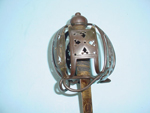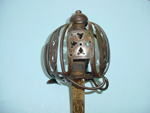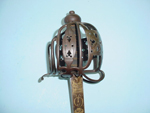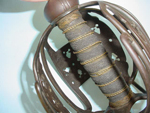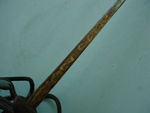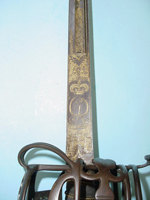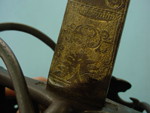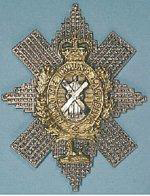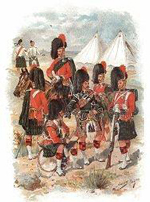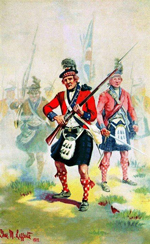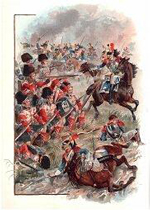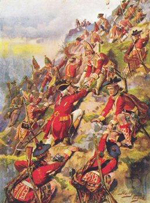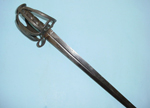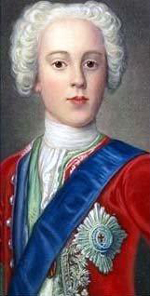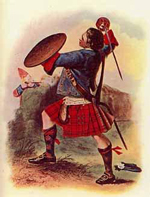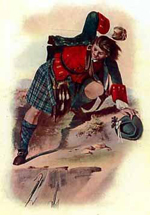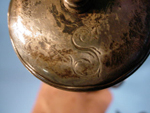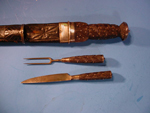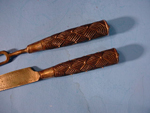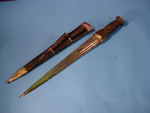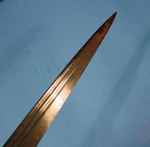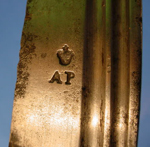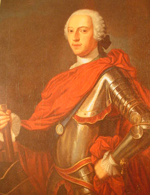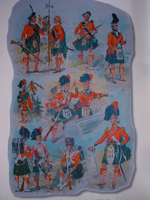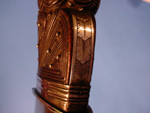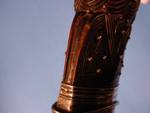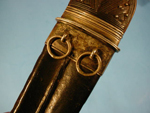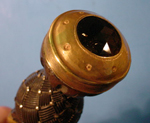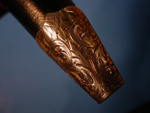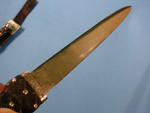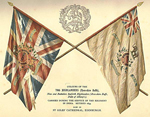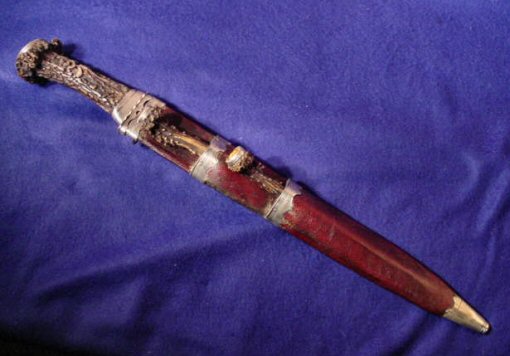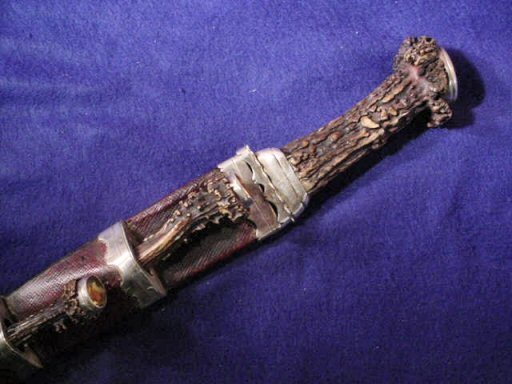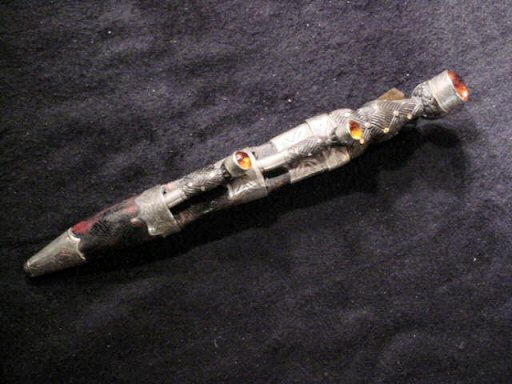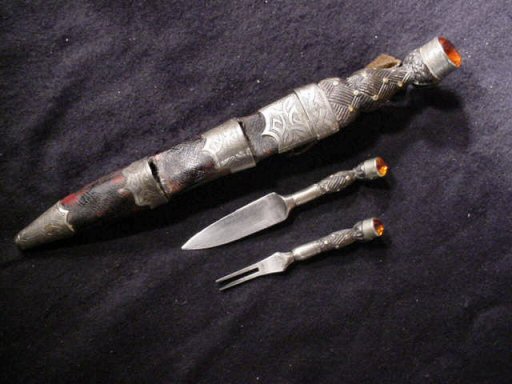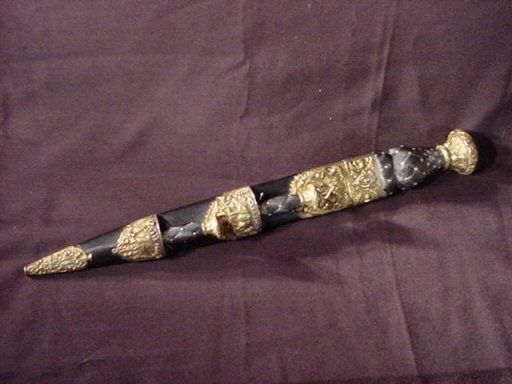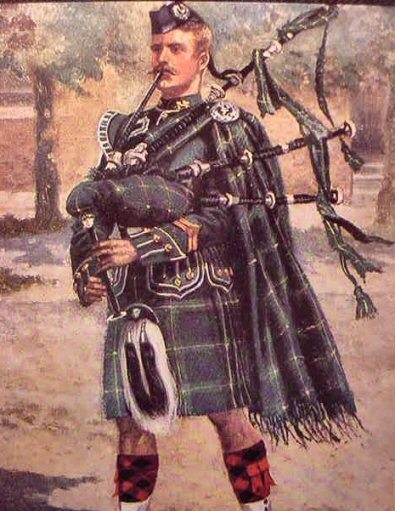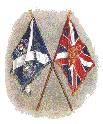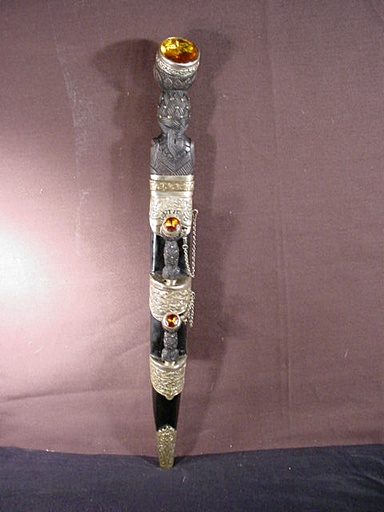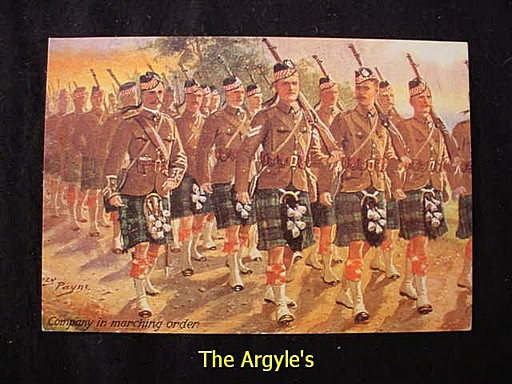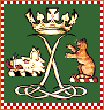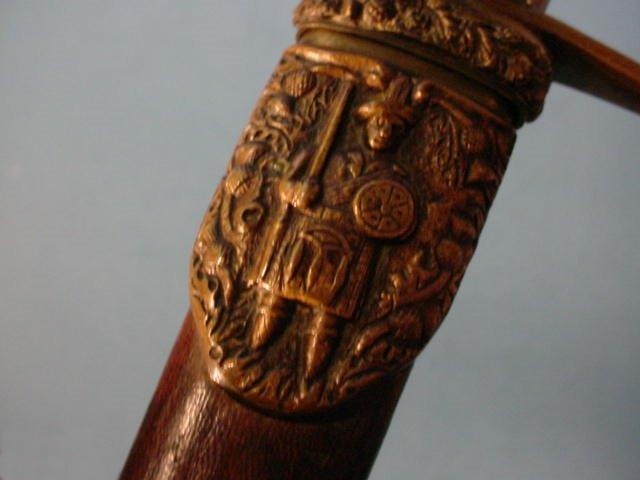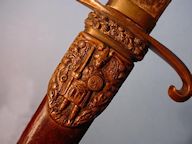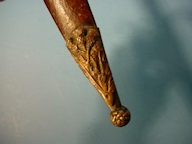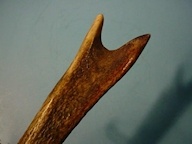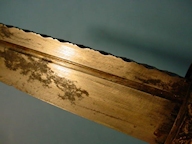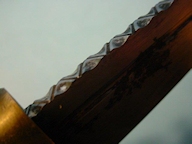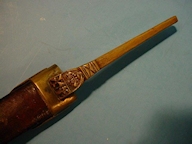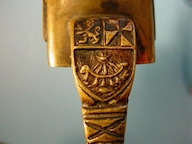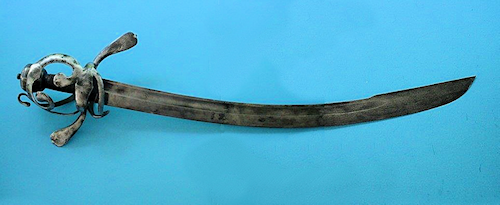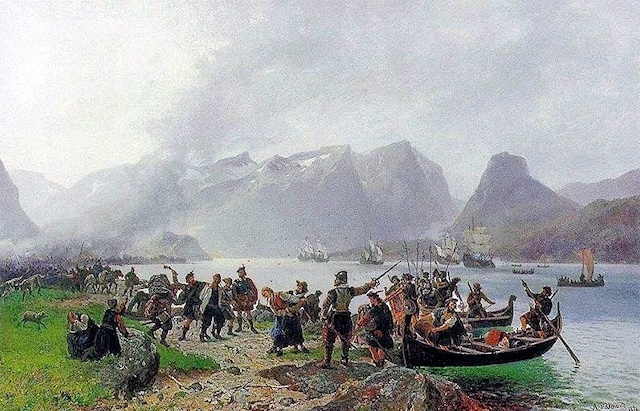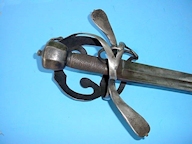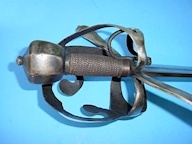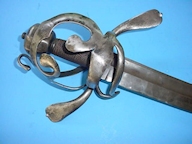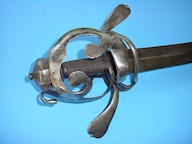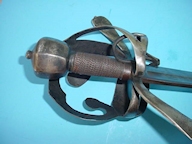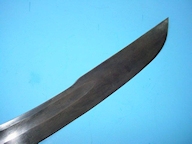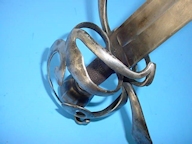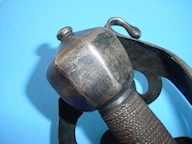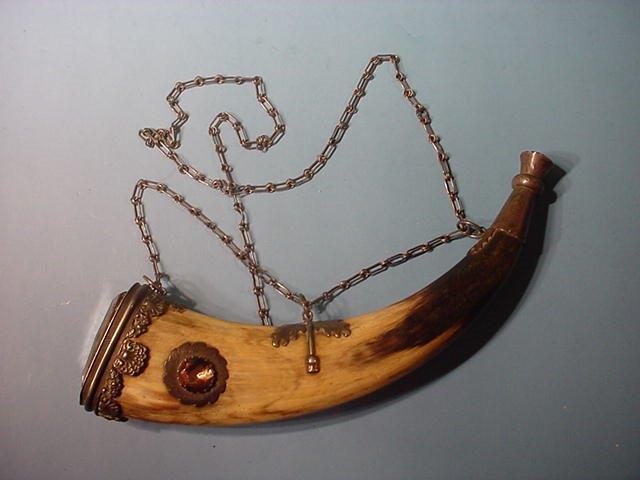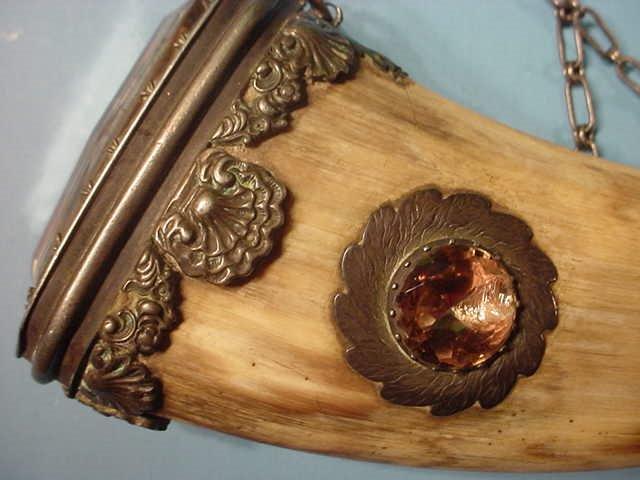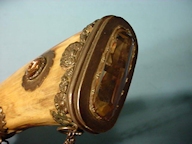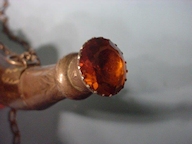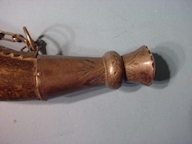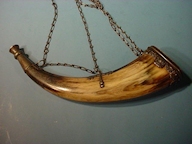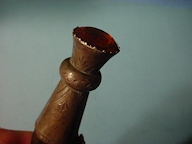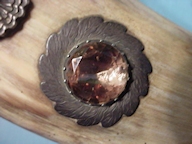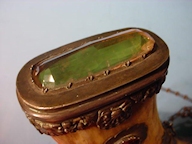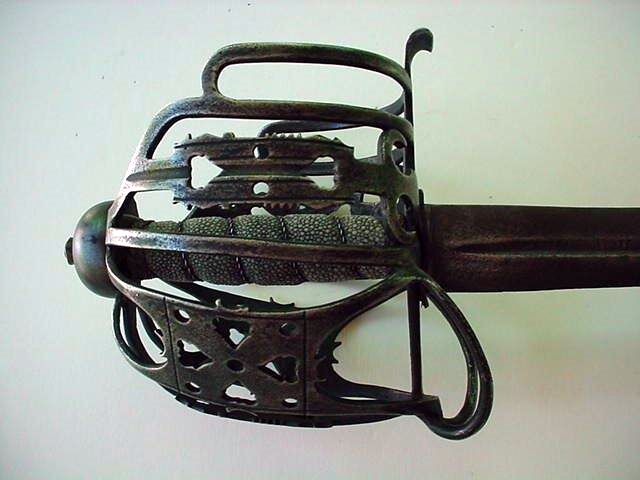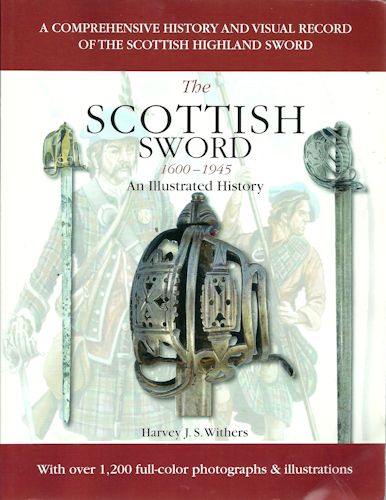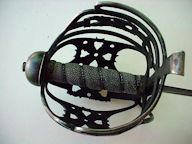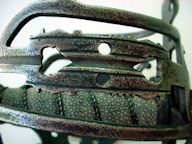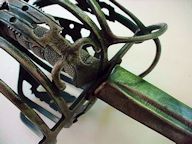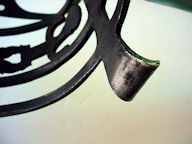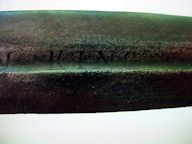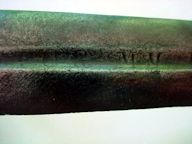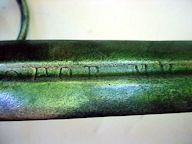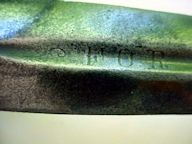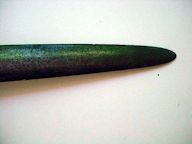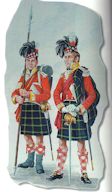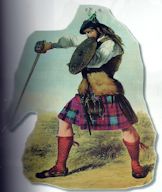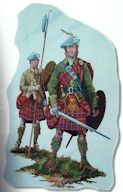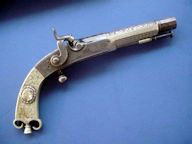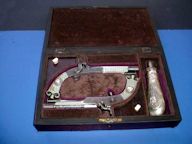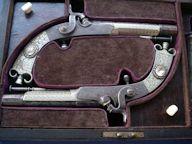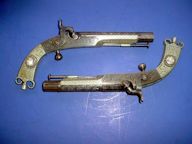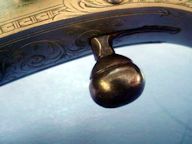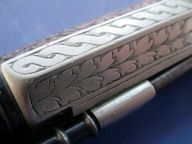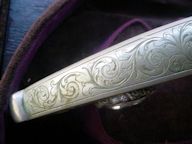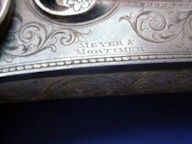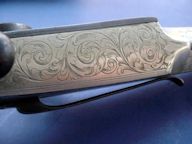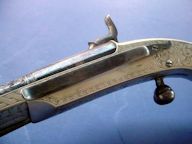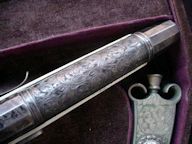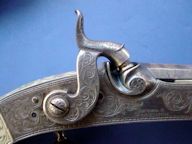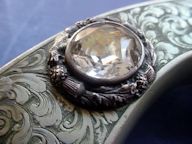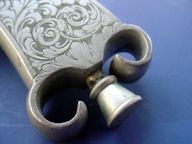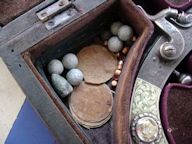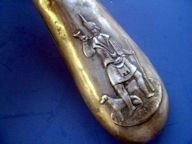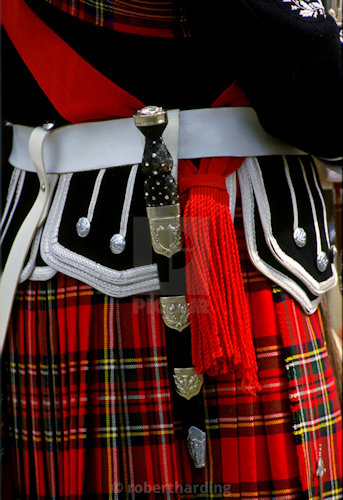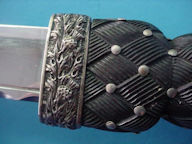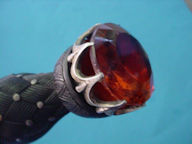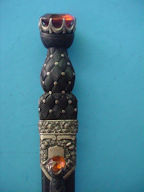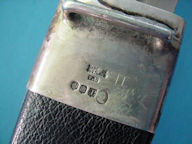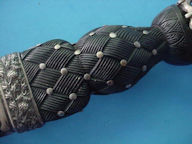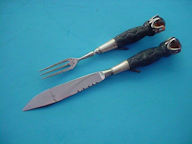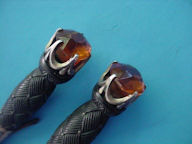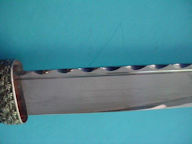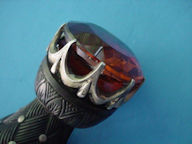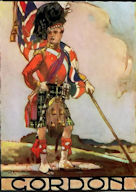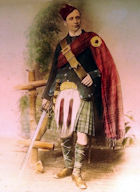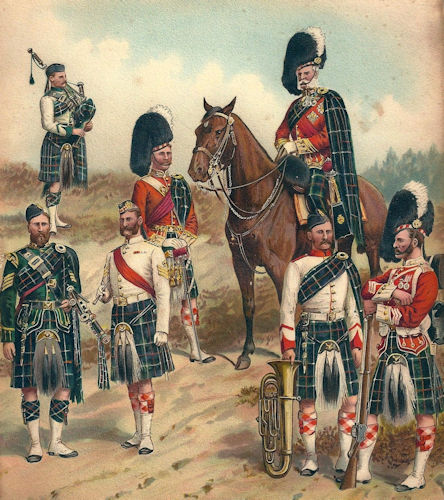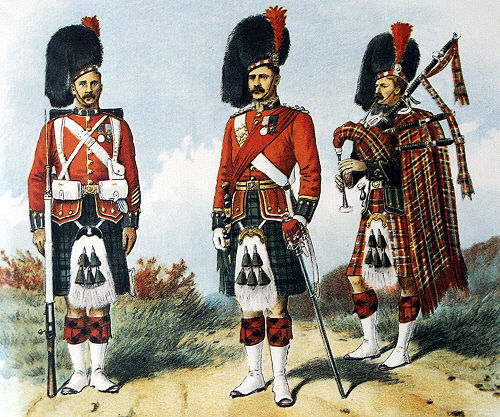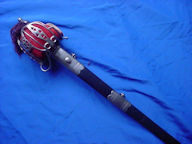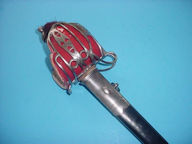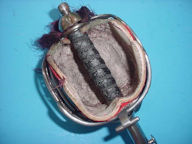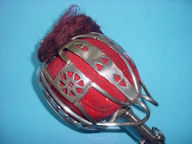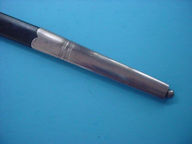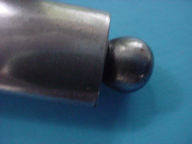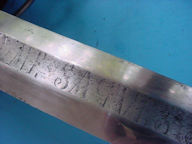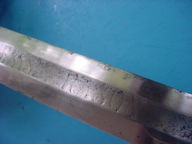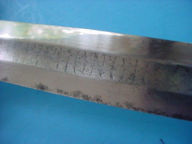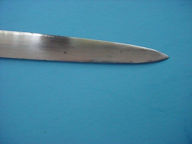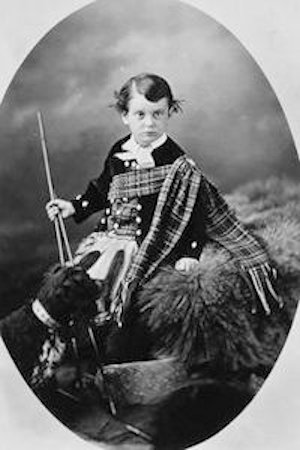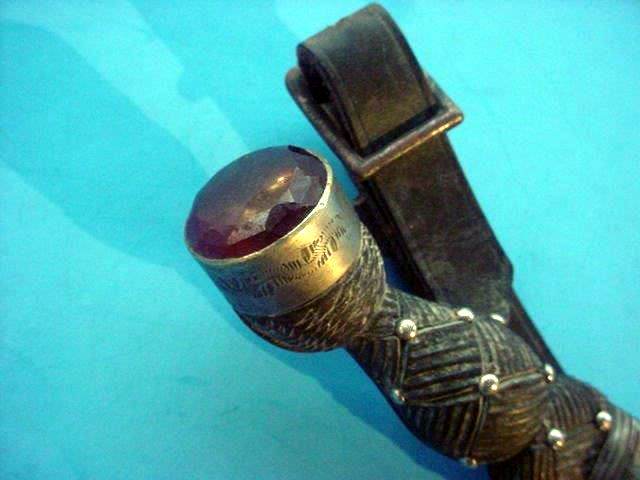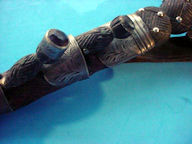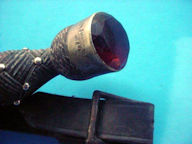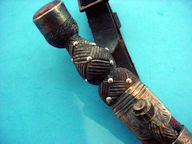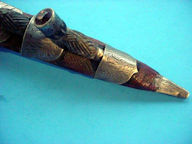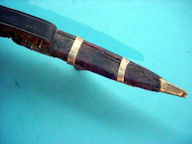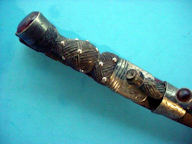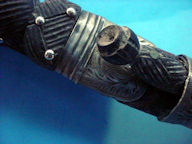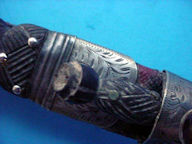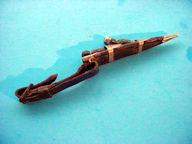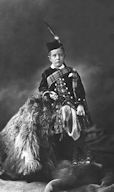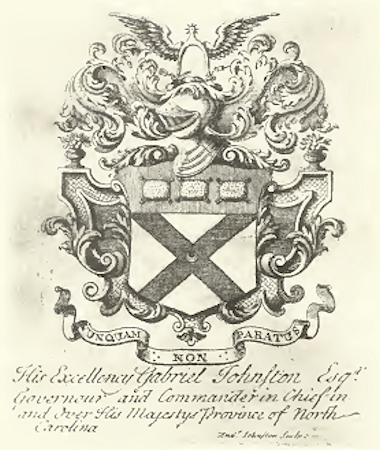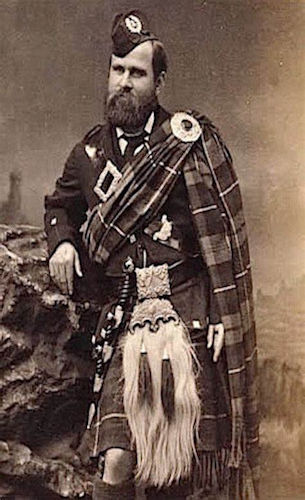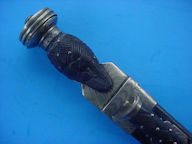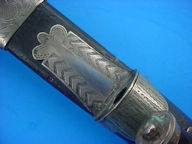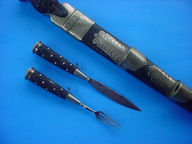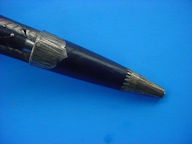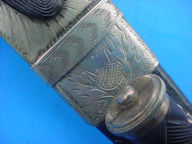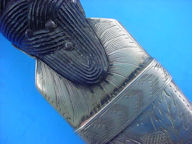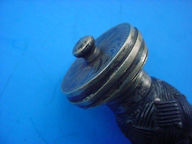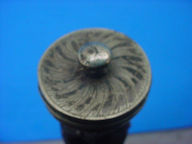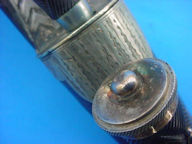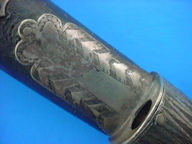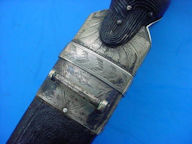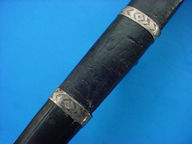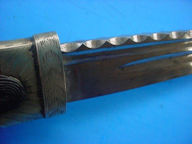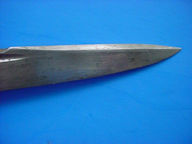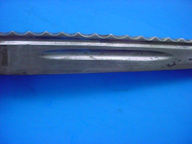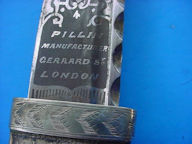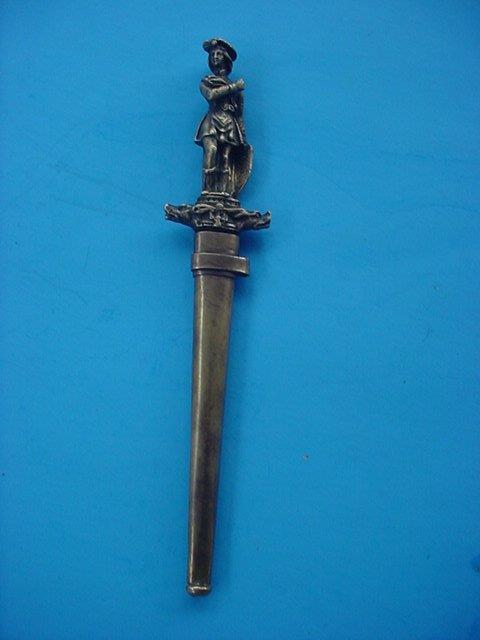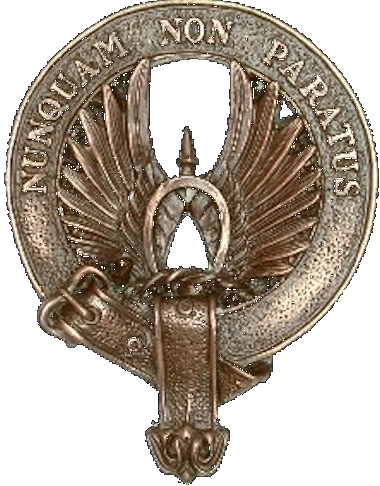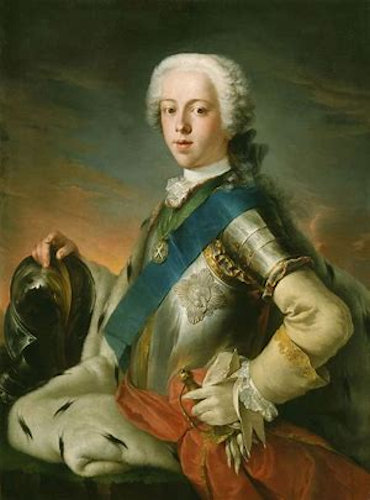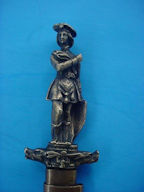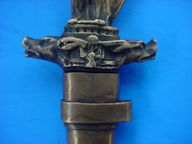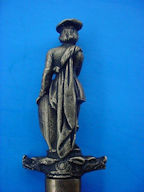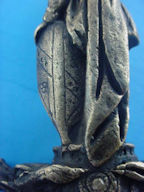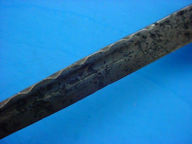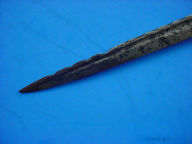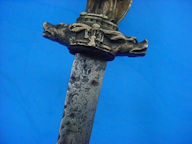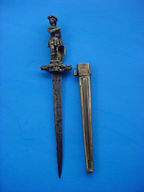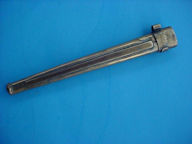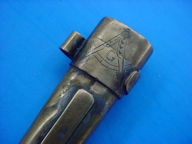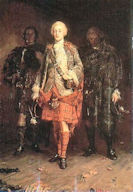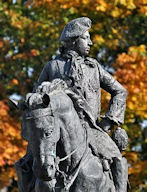|
|
|
|
Scottish Weaponry of Importance
Page 1
|
|
Here is our favorite subject here at Germania. No edged weapon in world history speaks to dash and daring and the tunes of glory resound down through the history of ‘Scotland the Brave’ like the Scottish basket hilted broad sword. They stand alone in their style; there have been imitations wrought by other nations such as England but the Claidheamh Cuil-Claymore when viewed ever brings sounds of pipes and the scent of the heather to mind. The Scottish firearms have a distinctive look also of course often employing a belt hook that secures it steady until called to use to defend Scotland’s honor or more personally the hearth and home. The Targe or shield is also distinctively Scottish and is seen in many patterns. But the highland sword, the basket hilted weapon practically stands with the rampant lion as the symbol of Scotia or Caledonia. Armed with the sword, the black dirk stocking knife (skeindu), the loyal Scot was one of the most formidable warriors that war has ever seen. The clans rose up to fight the English invaders several times but it was at Bannockburn 24 June 1314 that the most significant Scottish victory occurred . This was the greatest battle in the many wars for Scottish Independence. Hear the skirl o’ the pipes, and the heart thrills at the roll of the drum and now comes the battle cry ‘Scotland Forever’ and now it is the Claymore and dirk that command the field as Bruce the King ranks his Scottish men all in good order. Down on the lower ground 50 divisions wide Edward of England has crossed over the border! Armored from head to fist soldiers of Robert Bruce are waiting the order. “On them on them, here the double shout” smash their ranks in utter disorder! Now into the enemy strike in good order. “Freedom for Scotland" called Bruce the King and death to King Edward's men”. “Chains for the slaves” cried Edward the Murderer! And so it went for two days of glorious but bloody battle but in the end the Scottish victory was complete. Even now I can hear the lilting sound of the pipes as they are heard at that field of battle. The tune Flower of Scotland will always be the unofficial anthem and in song and music it refers to Scotland’s victory over Edward Longshanks and his men at Bannockburn. “Ready Aye Ready” Johnston border Clan motto My father used to say, “Pity the Mon who hears the skirl o’ the pipes and wha not born in Scotland!” Germania now presents our Scottish weaponry section: |
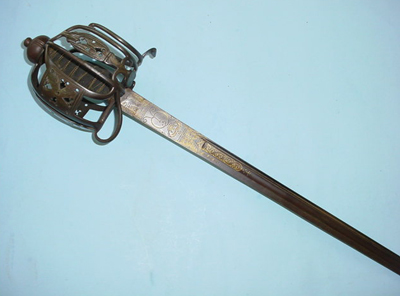 |
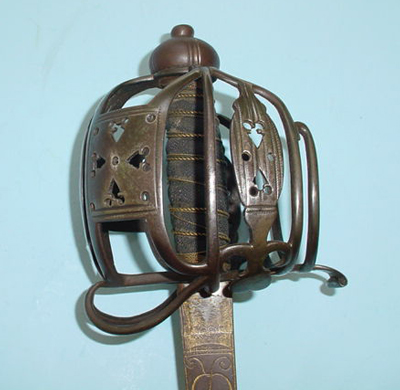 |
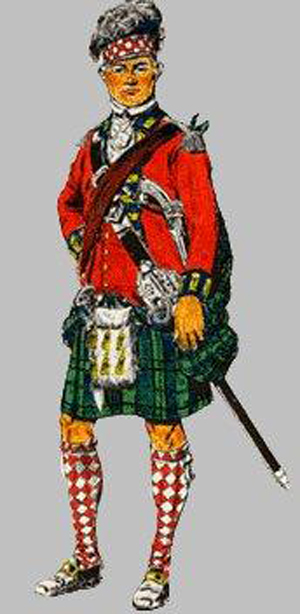 |
18th Century Scottish Royal Highlanders Sword (The Black Watch ‘Am Freiceadan Dubh”) (Item SCOTWEAPON 1-1) |
DESCRIPTION: Here is an officers' model of the Claidhermh MOR (Claymore); the hilt is Scottish about 1730; the blade German Saxon. It has an iron basket hilt with the typical wrist guard. Main knuckle guard engraved pommel, Main rear guard and additional rear guard, side knuckle guard and has the typical ‘rams horns’ terminal of the side guard. It has the forward quillion and saltire bars. The guards and main knuckle guards are cut out in the typical pattern of the 18th century broad swords of Scotland. The grip is of tightly wrapped ray skin or sharkskin but mainly what sets this sword apart from that of an enlisted ranks weapon is the beautiful engraved blade with the (GR) with crown standing for the Reign of George the 3rd 1760 to 1801. The sword was crafted before his birth and as we have mentioned the basket hilt dates about 1730 or possibly as late as 1745 or so but the blade is probably from somewhere around 1760 and is typically German with both wide and narrow blood fuller on the same sword (very unusual.); also the sword instead of being double edged as is usually found in Scottish swords it is single edged (a slashing as well as stabbing weapon). The blade was no doubt replaced during the late 1770’s. It is a fantastic looking blade with not only the cypher of George III but various fine floral motif included, the original gold wash shows in all its fineness. The sword's entire length is 39 inches. The royal Highland regiment is of course the “Black Watch” the 42nd Highlanders “The gallant forty twa!” Formed in 1739 with a long list of battles, a mutiny in 1743 and their baptism of fire was in the battle of Fontenoy in 1745 and they returned in 1745 to go straight into battle again during the Jacobite Rebellion. In 1747, they were stationed in Ireland for the next nine years, then the 42nd was sent to America (New York) and fought in the 1st battle of Fort Ticonderoga in 1758 against the French and losing half its troops in a valiant assault on the breastworks. Prior to the action at Ticonderoga, the Black Watch was given the distinction of being a Royal Regiment. The regiment took part in actions throughout North America and to include campaigns against the American Colonists as far west as Fort De Chartres on the Mississippi River in Illinois. So it is this period that we feel this sword hails from, so it is an important part of American history as well as European. It is the finest Claymore we have ever offered. It belongs in a good collection or museum. They come no better lads! “Nemo me Impune Lacessit." PRICE: SOLD |
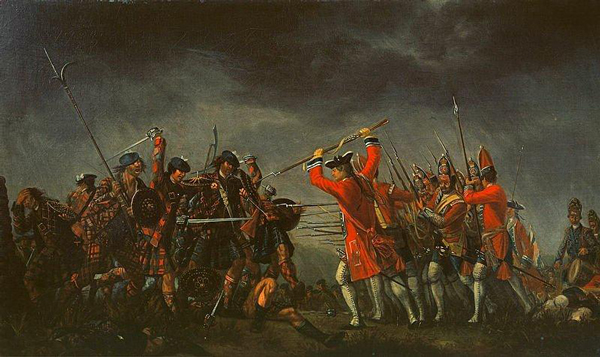 Battle of Culloden |
Basket Hilted Broad Sword “Claidheamh-cuil” “Claymore” (Item SCOTWEAPON 1-2) |
DESCRIPTION: Here is a broadsword -- but not the prettiest one we have ever offered but certainly the earliest and rarest. It appears to be from the mid-17th century and possibly used by Scottish Covenanters who joined with the English parliamentarians against the English King. Scottish troops played a major part in the defeat of Charles I, notably at the Battle of “Marston Moor.” But not all Scots supported the Covenators by taking arms against Charles who they considered their King, and a Scottish Civil War began in 1644 with a victory by Alasdair MacDonald with his victory at the Battle of “Tippermuir”. This sword could have been used in these early wars and most likely it was. It is definitely of that period and is the typical broadsword with “no frills” -- it is a deadly weapon with but one purpose and that was to fatally dispatch the enemy. This sword although from mid-17th century manufacture could and probably was used in the later wars. Very probably in the Jacobite uprising since almost every able bodied Scott was on one side or the other. Some supporting the Bonnie Prince and others the British Crown and it would naturally follow that every weapon worthy of its steel would have been brought to the fore in that glorious era but it was also a sad time of Scotland’s history. There are such basket hilted broad swords that are as primitive as this one in the book ”The Sword and the Sorrows” that chronicles the history the Culloden conflict. On page 44 in this marvelous guide you can see at least 3 of these early models. The book shows many of the Scottish weapons used through the various battles and conflicts that have occurred in Historic "Caledonia” (Scotland) -- the book is possibly obtainable from the National Trust for Scotland. It was the catalog from a great exhibition held to commemorate the Jacobite Rising of 1745 and the Battle of Culloden 1746. Many fine swords were on loan from the greatest collections in Europe. This sword measures three feet, two inches long. It has the early very plain basket with leather grip possibly restored somewhere along the years. The blade with short blood fuller is possibly made by an early Scottish swordsmith instead of being wrought by German Solingen smiths which is the usual. It has the iron basket. And shows the development moving toward the more familiar Claidheamh Cuil or Claymore. It has the forward quillion and forward guard plus the early style wrist guard but the rear quillion is different and the pommel is quite flat, unlike the sculpted pyramid shape of the later models. The main knuckle guard is quite open and there is virtually no main knuckle guard in evidence. Again it is a plain Jane as far as looks but a very lethal weapon all the same. It is rare to find a basket hilt of this very early period and only a few are in major collections and museums today. PRICE: SOLD |
 |
 |
Vintage Scottish Dirk (Item SCOTWEAPON 1-3) |
DESCRIPTION: Here is a classic example of the silver mounted Scottish dirk that is in the style of the early Biodag. This piece is probably late 18th century and is a truly fine example of the dagger of the Scots warrior. It is unpretentious; certainly a piece used in resplendent Scottish dress but also an effective weapon of close in combat. It was designed for effective killing whether of man or beast. The blood double grooves on the blade (fuller) demonstrate that this one is all business when it comes to Highland or Border Warfare against other clans or the bloody Brits. The blade of this dirk is a little over a foot long and the entire weapon measurement when sheathed is 17 ½ inches long. The blade is marked with a stamping that shows a crown and the letters AP; the small knife and fork nestled in the pockets of the scabbard are intact and in fine condition. Shown on the pommel of the grip on the surface is a crown and a letter S. This entails more research to be done. It may be a royal piece or at least it might have belonged to a highly placed officer of the Imperial guard. It certainly has the look of a piece beyond the ordinary. The fittings are silver, although unmarked, and the hanging device consists of two suspension rings instead of the usual bar that would fasten to the leather carry strap. This is usually indicative of officer ownership. One side piece in silver on the grip is missing. The silver nails (dozens of them) are all neatly placed in the Celtic carved grip with its intricate pattern that emulates the Scottish Thistle (the national flower). Think of the old Scottish ballad “The Flower of Scotland”! So here we offer one of the finest early dirks that we have ever seen. So typical yet so rare! Listen closely as you view the pictures and you just might hark and hear the pipes as they spell out “Scotland the Brave”. PRICE: SOLD |
 |
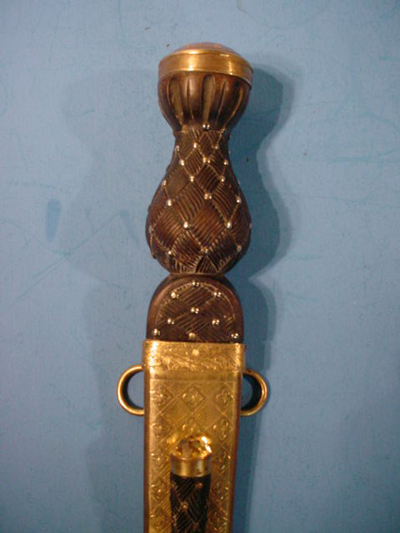 |
High Occasion Dress Highland Dirk (Traditional Early Style) (Item SCOTWEAPON 1-4) |
DESCRIPTION: This is a very special Scottish dirk of the style of the early 1800’s. This was the era when the pommels went from flat to the more decorative ball style and rather than being an effective fighting weapon the dirk became an object of traditional dress wear. The Cairngorm and other precious stones were added to the pommel as the highest decorative point; some of the Cairngorms were particularly precious and of course always hand-cut by the finest jewelers and often encased carefully by a brass or silver box-like mounting done up as a priceless diamond might be displayed. That is the case here in this very special mounting. Cairngorm stone is also referred to as Smoky Quartz and perfect specimens were highly regarded and treasured. So now and then you will see an example where the stone is mounted as a diamond might be. That is the case here in this example. This dirk is of course traditional to a point. The grip is of the type made to represent the Scottish thistle. These grips became common by the beginning of the 18th century. The fashionable looking nails adorn the grips and the carving on the grips are from interwoven bands of knot work to a style looking much like basket weave. Where this dirk takes off on its own is not only in the pommel but in the fact that it has an all metal scabbard highly engraved and in the style adopted after the ‘45’ Jacobite rising. Almost every Highland dirk you will ever see has a leather scabbard with metal supported pockets for the knife and fork and the throat and boot would be metal as well. This one with all metal scabbard makes it in all probability unique! The knife and fork set also have precious stones in their pommels but are not Cairngorms but rock crystal as was often used as well in these dirks. The suspension for hanging the dirk from the belt is also different and instead of the welded bar that would accept a clip, this one has two brass rings only ever seen on the high dress regalia dirks. The blade is brilliant with deep blood fuller and the very traditional decorative file work known as ‘jumping’ on the unsharpened back edge of the blade. So, among Scottish dirks this one would rank as a particularly fine treasure, rare and beautiful. It measures 16 inches in length with a blade measuring 8 ½ inches long. On the back of the scabbard it has a rectangular box with the name of the maker or possibly it was the retailer. It says K. Fraiser & Co. 17 Saint Andrew St. (Edin) and this last is an abbreviation for Edinburgh. We would reckon this dirk to be of the early Victorian age about 1840 or so. We have never in our travels through Scotland and Britain seen another of these in museums or in fine collections. It is indeed a rarity but priced very competitively. A true museum specimen. PRICE: $3,950.00 |
 |
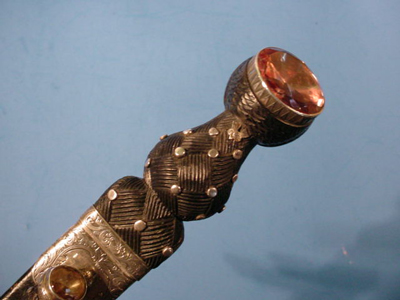 |
Cased and Presented Scottish Dirk of the 78th Highlanders (Item SCOTWEAPON 1-5) |
DESCRIPTION: This is one of the neatest Highland dirks we have ever encountered; it is a scaled down version worn in military dress. However, this one was only about ½ the size of the normal military model and specially constructed for a piper and possibly unique! It was presented to a piper named Donald Fraser in 1876. In 1757 the 78th Fraser Highlanders were raised by Lt. Col. Simon Frazer of Lovat and sent to fight the French in the French and Indian War; it was disbanded in 1763 but the name still lives with the 78th Highlander Regiment of foot that was raised in the late 18th century for service against the French in the Napoleonic Wars. Later the regiment fought bravely in many a fray at Maida, Java, Koosh-ab and Persia, Lucknow during the Indian Mutiny of 1857, and Afghanistan 1879-80. Then at some point they were amalgamated with the Seaforth Highlanders and fought at Tel El Kasir, Egypt 1882, the Chritral Expedition 1895, Albara, and Khartoum. Their battle history is replete with heroism and glory and though the years their pipe band has been the best of all the Regiments. This dirk was presented to Donald Frasier for his excellent performance and wining a competition of the tradition bagpipe chanting known as Piobaireachd. This is a team that basically means the art of piping. The words Pibroch and the Gaelic Piobaireachd are also referred to by some in the older almost ancient word Philbrochs. But all of them are used by pipers from various regions and military regiments in Scotland. “Pity the man who hears the Skirl o’ the pipes and wha’ not born in Scotland.” The dirk is magnificent with silver fittings and a beautiful rose topaz in its pommel. The grip is fashioned from bog oak with fifteen silver studs imbedded in it. The small knife and fork have cairngorm crystal stones in their pommels. All fittings are in silver. At the throat of the scabbard is the name of Donald Fraser 78th Highland Rgt. 1876. Note: the name Fraser (Fraser Highlanders) I’d say due to his name this might have had a wee bit of influence on the judges. What say ye? But they must have really appreciated his performance to present him such a glorious gift as this. The dirk scaled down would fit in well when wearing the high dress regalia with its tuxedo style tunic. The dirk is a little over 10 inches long in its scabbard. The blade is quite plain and is in great shape. The entire dirk is almost mint condition. It still, remarkably, has its original presentation case with snap lock and it has the presentation words on the top: Donald Frasier They used the Gaelic name for what we call Pibroch (Philbrochs). The Fraser Highlanders were the first to use the bio- dag or dirk as we know it today in its decorative form like this one we offer here. This petite weapon is obviously very beautiful but prodigiously important to history as well. PRICE: SOLD |
|
|||||||||
|
Scottish Hunter’s Dirk (Item SCOTWEAPON 1-6; BRITSCOT 1-7) SOLD |
|||||||||
| DESCRIPTION: This is a very rare Scottish dirk of the type once used by Scottish Highlanders who hunted in the mountains. This magnificent dirk is mounted with pure silver fittings. The scabbard is fitted with brown leather and is thus quite different from the dress dirks used by Scots on parade and ceremonial functions. Those were normally quite elegant in appearance. This one is more than elegant. It was designed and used in the hunt for the elusive red, highland stag. The grip is of stag’s horn (used only on the hunting pieces). The Cairngorm-stone mounting on the top of the grip is repeated in smaller size on both of the smaller stag-gripped eating appurtenances (knife and fork). Actually, the dirk with these accouterments was the original historical form for the later, fancy dirks. The dirk was originally a hunter’s weapon for the “Sport of Kings,” but also as a defense against brigands and highwaymen. The small knife and fork were handy utilitarian tools that were used at mealtime in the mountains and glades. The tradition of the Cairngorm stones and usage of silver was not decorative alone. Tradition has it that if the highlander should finally expire along the ‘high road or low road’ and his remains be found, the Scottish wayfarer finding him would take the valuable dirk and it would either be his reward for his assistance in burying the man or selling the dirk for funeral costs. Only in Scotland of old could this be counted on; not in liberal Scotia of today. The blade has the serrated edge used for various purposes in dressing the fallen game. There is some rust pitting about one inch down from the grip on the blade where a constantly worn item like this is most exposed to the elements. The blade is about 12 1/2 inches long. The entire dirk is 19 1/2 inches long (unusually long). This is a museum piece without a doubt and should be the pride of any collection of Scottish cultural items.
PRICE: SOLD |
|
||||||||||
|
Child’s Skein Dubh (black dirk) (Item SCOTWEAPON 1-7; BRITSCOT 2-7) |
||||||||||
| DESCRIPTION: Here is a charming little lethal weapon as given to a trusted minor. It’s just a nice little dirk in miniaturized size. Other than that it’s an exact duplicate of a full-sized Scottish dirk. It has all the Celtic engraving on the various parts and genuine Cairn stones (agate) in the main dirk and in the hilts of the small knife and fork. At best guesstimate we would say that this piece dates from the 1880s or 1890s. It has the leather carry strap and the leather-covered scabbard is scuffed a bit, but is all intact. It has the traditional serrated blade. The overall length is about 9 3/4 inches. The blade is about 5 3/4 inches long. This is an unusual child’s dirk in that it even has a blade. Usually these had no blade at all and were simply a decorative accoutrement to a child’s highland outfit. This one, however, being 100-percent complete indicates that the child was trusted and under a strict discipline known usually in the landed gentry or royal families of Scotland. This is a rare museum-worthy relic.
PRICE: SOLD |
|
||||||||||||
|
Scottish Black Dirk (silver mounted) (Item SCOTWEAPON 1-8; BRITSCOT 2-9) |
||||||||||||
| DESCRIPTION: This is a fine, proud Scottish dirk of the piper variety. It is silver mounted, but bears no silver designation or hallmarks. In the military style it has the seal of Saint Andrew that seems to be expertly hand engraved and is flanked by two sprays of acacia branches. The letters ‘IBMN’ appear to be also done by hand on the facing of the silver pocket that accepts the small knife of the knife-fork set. On the facing of the fork compartment is ‘NIC.’ The length of the piece is 18 inches overall. The blade has the typical serrated edge running down three quarters of the length. The grip with hand-carved Celtic knots is also studded with silver pinions. This is just a superior dirk of the finest quality throughout. Circa: 1850.
PRICE: $3,250.00 |
|
||||||||||||||||||||||||||||||
|
Foot Dress Dirk of the 74th Highland Regiment (Item SCOTWEAPON 1-9; BRITSCOT 2-10) |
||||||||||||||||||||||||||||||
| DESCRIPTION: Here is one of the finest military dirks we have ever seen. It’s from one of the finest Scottish regiments that bonnie Scotland ever fielded. In 1881 it was formed as Highland light infantry. This elite regiment had the battle honors of SERINGAPATAN, ASSAYE, BUSAGO, FUENTES D’ONOR, CIUDAD RODRIGO, BADAJOS, SALAMANCA, VITTORIA, PYRENEES, NIVELLE, ORTHES, TOULOUSE, and PENINSULA all listed on its gorgeous blade. The regiment was formed in 1787 for service in India when war with the French was imminent. Its regiment badge, with the elephant subscripted beneath “Assaye,” was named for the Battle of Assaye in 1803. Wellington described it as the bloodiest of all battles fought. The 74th was one of the regiments given this coveted battle honor. This was the key battle of the Second Maratha War in India. The regimental motto—“NEMO ME IMMUNE LACESSIT,” “Nobody provokes me with impunity!”—is seen in relief in the band that encompasses the area where the grip meets the blade and again engraved on the blade itself. This was also the motto of the Order of the Thistle. The saying is also on the Scottish national coat of arms. A story in supreme heroism attends the saga of the 74th aboard the temporary military transport ship Birkenhead, which struck an uncharted rock off the South African coast while carrying British troops heading to fight in the Frontier War, a detachment of the 74th Highland Regiment was aboard. There were three lifeboats sending women and children to shore in three roundtrips. The term “women and children first’ was established during this evolution. This type of orderly evacuation is still known as the “Birkenhead Drill.” Only 193 people were saved. The men of the 74th, who were not required to organize the evacuation, calmly stood in formation as the deck of Birkenhead broke up beneath them. Along with these brave men stood the two regimental pipers who piped the tunes: “Flowers of the Forest,” “Scotland, the Brave,” and “Nearer my God to Three.” Most of them drowned; there were sharks. Full well, they earned their pay! The 74th was certainly one of the most glorious regiments of Scotland. The dirk is in beautiful condition throughout and it dates from the time of Queen Victoria, whose crown is seen at the top of the etching on the backside of the beautiful blade. One of the Cairngorm stones has been replaced. The one in the little fork inserted in the scabbard pocket but it is indeed a genuine Cairngorm stone (amethyst) replacement. The other amethyst stones are of the lavender coloration (very rare). The dirk measures about 17 1/4 inches long in its scabbard. The blade length is about 11 1/4 inches long. This is about the most handsome military dirk we have seen and in such practically mint condition. (Nay finer a wee dirk exists!)
PRICE: SOLD |
|
|||||||||||||
|
Black Dirk with Celtic Dragon Motif (Argyll’s) (Item SCOTWEAPON 1-10; BRITSCOT 3-12) |
|||||||||||||
| DESCRIPTION: Here is a very beautifully designed skein du or black dirk. It is a large one measuring 19 1/2 inches long. It has a traditional Celtic design employing fierce Celtic dragons that do battle with each other. Hidden among the design are symbols on the throat, center bands, and tip. A Masonic compass can also be detected on this tip. The 11 1/2-inch blade has the ripple effect on its backside three quarters of the way down the blade. The boar’s head of the Argyll and Sutherland highlanders is seen on the top-middle band, while the black cat of the Argyll’s is evident on the lower band. They took the boar and cat of the regimental badge and divided them in an artistic way of depiction (very unusual). At the top throat band is the crowned crest of the Argyll regiment. This is the crown of the royal princess. This is attributable to the fact that this regiment was Princess Louise’s Argyll and Sutherland highlanders. They were an elite group that in my opinion should not have served in the British Army. Bruce & Wallace probably do not rest easily in their graves. Scotland should be entirely independent of the Sassenach! Does this make the Brits sound like a bunch of homicidal maniacs? Read Scottish history then make the decision for yourself. My fervent Scottish prejudice is showing, isn’t it? Back to the dirk. It is truly a different and rare piece. It’s wholly military and in good condition. It’s unnamed as to make, but surely well made! The Cairngorm stones are bright and uncracked. We believe this dirk to be WWI era. It’s silver plated with leather scabbard. The blade is unrusted and fine. There is a bonny dirk for the discriminating son of Scotia.
PRICE: SOLD |
|
|
Very Unusual Scottish Dirk (Item SCOTWEAPON 1-11)
PRICE: $695.00 A Wee Bargain!



